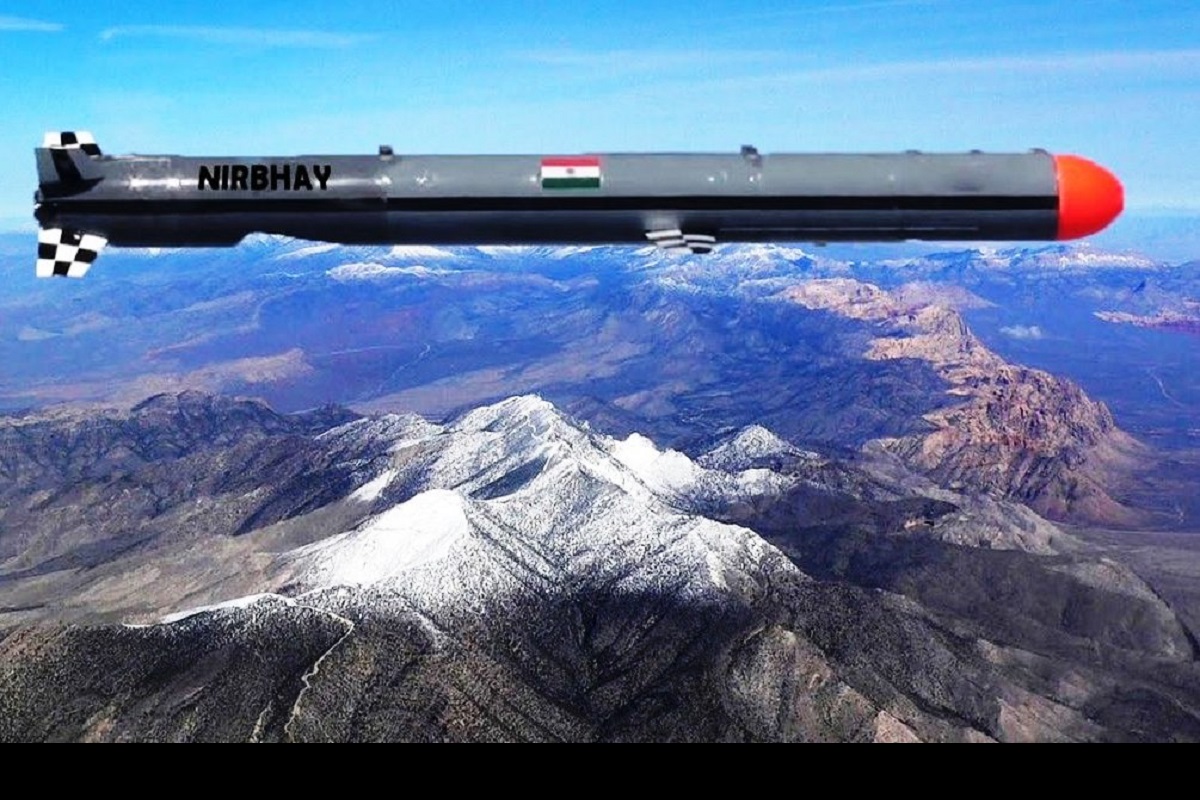Nirbhay & it's specs

Possessed by : India
Class : Subsonic Cruise Missile
Length : 6.0 m
Diameter : 0.5 m
Launch weight : 1,500-1,6000 kg
Payload : 300 - 450 kg
Warhead : HE, submunitions, 12 kT nuclear potentially
Propulsion : Turbojet, manik Turbofan (1st stage - solid fuel, 2nd stage liquid fuel)
Range : 1,000+ km (based on payload)
Nirbhay subsonic cruise missile was designed by DRDO’s aeronautical systems design division, Aeronautical Development Establishment (ADE), which is located at Bengaluru. Advanced Systems Laboratory (ASL), based at Hyderabad, developed the weapon’s solid rocket motor booster and the Integration of the missile was carried out by DRDO’s Research & Development Establishment (Engineers), Pune (R&DE).
The projectile is designed to deliver similar loitering capabilities, control and guidance, as well as the accuracy and stealth capabilities of America’s Tomahawk and Pakistan’s Babur missiles. Nirbhay is an addition to the Indian arsenal, which includes Brahmos, a short-range supersonic cruise missile jointly developed by India and Russia.
The first test-firing of Nirbhay was terminated midway after the missile deviated from the intended path. It was trialed a second time using a solid booster and a turbo-jet engine during the cruise phase.
It took more than one hour and ten minutes for the first flight test mission to be completed from lift-off to final splash down. The propulsion was initially provided by booster motor while the turbofan engine powered the further flight. Stabilization was given by wings, which were unfolded by commands from the onboard computer.
The missile uses a solid propellant booster motor that is jettisoned shortly after launch, switching over to a turbojet engine with a cruise speed of 0.80Mach and a reported range of 1,000+ km.while maintaining accuracy of above 3 - 10 m during its trajectory. The missile, carrying a dummy payload, reached a distance of 1,000+ km . The complete mission was tracked by indigenous telemetry stations and closely observed by an aircraft of the Indian Air Force. The missile is guided by INS/GPS with an active-radar terminal seeker, and its accuracy could be improved both by the development of an indigenous Indian navigation satellite system and the potential of integrating the seeker from the BrahMos missile.
Features
Nirbhay subsonic cruise missile has a length of 6m and a diameter of 0.5m, whilst it’s launch weight is approximately 1,500kg. The missile has an operational range of approximately 1,000+ km and can cruise at a speed of Mach 0.8.
The weapon can carry warheads ranging between 300 kg and 450 kg. A total of 24 types of warheads can also be attached to the missile, based on the mission requirements
A highly advanced inertial navigation system, which was indigenously developed by Research Centre Imarat (RCI), guides the weapon. The missile can reach flight altitudes 500 m and 4 km above the ground and can also fly at very low levels to avoid detection by enemy radar.
Nirbhay has the capability to penetrate deep into the enemy territory and can engage targets with high-accuracy. It can also be launched from multiple platforms including aircraft, land-based vehicles/launchers, ships and submarines.
Launch vehicle
Nirbhay missile is launched from a LPTA 5252-12 x12 all-terrain and all-wheel drive mobile launch vehicle. This launcher was developed by Tata in close coordination with the Vehicles Research and Development Establishment (VRDE) at Vahannagar .
Power for the vehicle comes from a heavy duty engine mated to an automatic transmission. The launcher is also installed with anti-locking braking system (ABS) and central tyre inflation system (CTIS) for high-mobility.
Stunning sea-skimming capablity of Nirbhay cruise missile!!
"Thank you Anantha krishnan sir for this amazing video"
click the link to watch
https://www.youtube.com/watch?v=xN37tSrYWaM
(Above information are taken from various sources & cannot guarantee the information are accurate)

Comments
Post a Comment